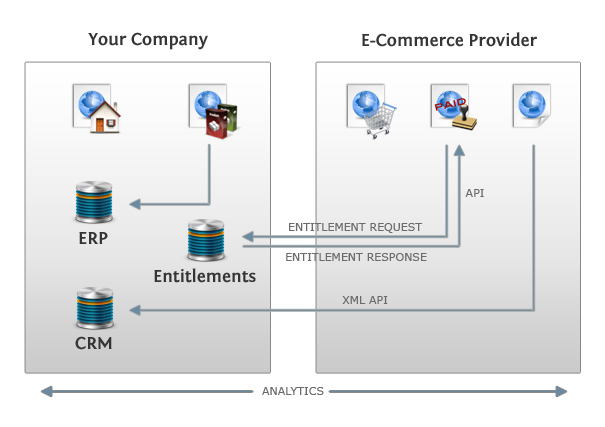When deciding to out-source your e-commerce infrastructure, poor planning can sabotage even the most thorough vendor selection process.
Whether you sell software, subscription products or access to content, it’s important to address all the possible communication points between your corporate enterprise systems and the e-commerce platform.
Otherwise, minor points like foreign currencies, orders waiting for payment or Internet outages may turn into major production problems.

Whether you have built your e-commerce infrastructure in-house or have been using an out-sourced partner, implementing a new, state-of-the-art e-commerce platform requires a lot of thought.
Here are a list of important integration points that you should make sure to discuss with any potential e-commerce partners:
- CRM/ERP integration – Informing master customer database of each transaction
- Entitlement allocation – Customer buys your product and needs entitlement granted
- Seamless user experience – Web page branding, custom domains, customer specific data passed to pre-filled carts
- Entitlement validation – Qualify customer to buy specific product
- Single sign-on – Customer logged in to each system simultaneously, your side should be the the master and your e-commerce provider the slave
- Hosting of data files – Whose Content Delivery Network (CDN) to use, impact on tax nexus
To go into detail about the above items would be too much to cover in one blog post. However, any reputable out-sourced e-commerce company will offer an extensive list of APIs to address these typical, but sometimes complex issues. So make sure these items are on the table for discussion.
After you have tackled the integration points, it’s important to talk to your potential e-commerce provider about the following hidden trouble spots that you may encounter when completing your integration:
- Delayed access to delivering or receiving real-time purchase notifications– If you are receiving order data from your e-commerce platform following each transaction, you need to have a plan to handle orders that are:
- Not received due to temporary internet outages
- Received in an unfamiliar format
- Not received due to planned maintenance
- Lack of double-byte enabled systems – Orders that come from countries such as Japan, China and Russia include (if your e-commerce system allows it) double-byte characters, which require more data storage than Western character sets like ASCII. If your internal systems are not prepared, the data sent may not be captured properly or at all in your database, causing inconsistencies later.
- Analytics integration – Make sure your e-commerce provider is tracking customers once they leave your hosted pages and are transferred to the e-commerce platform pages. Not doing so results in a lack of visibility into the full customer purchase process.
- Accounting system currency reconciliation – Moving from an in-house system to a globally focused e-commerce platform usually entails exposure to more currencies than you may have supported initially. Find a way to allow customers to pay for your product in their local currency that also supports automated input into your accounting system so that you don’t dilute the benefit of accepting more currencies.
- SKUs in ERP system – Many ERP systems are configured with specific SKUs for your products that are not as flexible as some external systems. Be sure to map ERP-listed SKUs to your e-commerce platform SKUs to avoid products selling in production, but not appearing in your accounting system.
- Resellers and affiliates – Selling via resellers or affiliates requires detailed communication to ensure that your partners are familiar with and comfortable using your new e-commerce platform. Make sure that you plan a migration path with your new e-commerce provider.
- Customer service policies – Procedures handling daily processes like refunds, chargebacks, underpayments and other customer issues need to be communicated to your partner to ensure a common message is provided to all customers. Great customer service is a real differentiator – don’t ruin your reputation by not preparing in advance!
Embarking on a new e-commerce platform selection project is a daunting task. And the work doesn’t end once the selection is made – the real risk begins when it’s time to align your internal systems with your new e-commerce platform.
More time spent planning for the implementation (and asking the right questions) will result in fewer unforeseen circumstances in spite of the additional time required to reach go live status.
Using the right tools is critical to a successful result in such a large project. Here are some tools that can help you better prepare:
- Flow chart software to draw use case scenarios and process flow charts
- Project management software to identify task owners and visualize dependencies
- Dedicated sandbox testing environments that don’t impact existing production systems with unstable programs and procedures
With the discussion topics above and these tools to help you get organized, you won’t miss a beat during your e-commerce outsourcing project.
Keystone
When implementing a new e-commerce platform, the more planning you do in advance, the fewer errors you’ll have when flipping the “go live” switch.
What kinds of tools have you used to help you? Any little gremlins that you never think of that always pops up when going live?